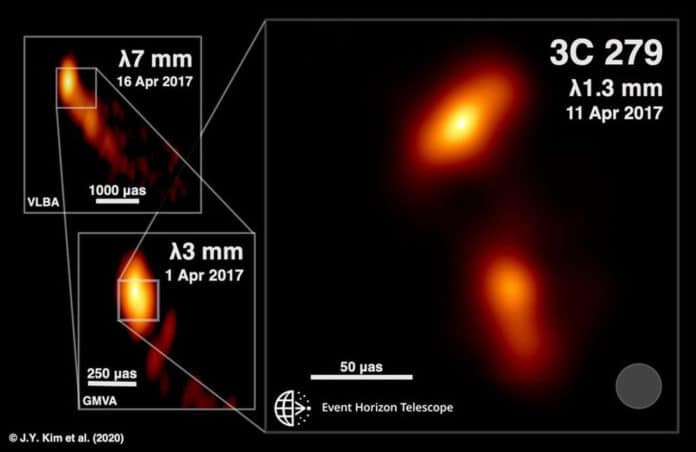While gathering data to create the first image of a black hole, Event Horizon Telescope was also busy in observing an even stranger object: quasar 3C 279. The telescope had found the finest detail ever in the relativistic jet that is believed to originate from the vicinity of a supermassive black hole.
In a new analysis by the Max Planck Institute for Radio Astronomy in Bonn, astronomers studied the jet’s fine-scale morphology close to the jet base where highly variable gamma-ray emission is thought to originate. Using the technique called very long baseline interferometry (VLBI), astronomers observed that the jet has an unexpected twisted shape at its base.
VLBI allows the EHT to achieve a resolution of 20 micro-arcseconds — equivalent to identifying an orange on Earth as seen by an astronaut from the Moon.
This is for the first time; astronomers observed features perpendicular to the jet, which first could be interpreted as the accretion disk from where jets are ejected from the poles.
Although how any of this occurs, remains unclear. But, astronomers think that it could have something to do with how the jets meet the accretion disk surrounding the black hole.
Jae-Young Kim, leader of the analysis, is enthusiastic and, at the same time, puzzled: “We knew that every time you open a new window to the Universe, you could find something new. Here, where we expected to find the region where the jet forms by going to the sharpest image possible, we find a kind of perpendicular structure. This is like finding a very different shape by opening the smallest Matryoshka doll.”
“Furthermore, the fact that the images change so fast has also surprised astronomers. Relativistic jets show apparent superluminal motions, as an optical illusion, but this, perpendicular to the expectation, is new and requires careful analysis.”
Thomas Krichbaum, who designed the observations of the source back in 2016 as Principal Investigator of the project, notes the challenging data interpretation: “Motion in transverse jet direction is difficult to reconcile with the simple understanding of an outward propagating relativistic jet. This suggests the presence of propagating plasma instabilities in a bent jet or internal jet rotation. 3C 279 was the first source in astronomy to show superluminal motions, and today, almost fifty years later, still has some surprises for us.”
The telescopes contributing to this result were ALMA, APEX (jointly run by MPIfR, ESO, and OSO in Sweden), the IRAM 30-meter telescope, the James Clerk Maxwell Telescope, the Large Millimeter Telescope, the Submillimeter Array, the Submillimeter Telescope, and the South Pole Telescope.
The author list of the present paper includes thirty-seven individuals affiliated with the MPI für Radioastronomie, namely, in order of appearance: J.Y. Kim, T.P. Krichbaum, T.K. Savolainen, W. Alef, R. Azulay, A.K. Baczko, S. Britzen, R.P. Eatough, R. Karuppusamy, M. Kramer, R. Lico, K. Liu, A.P. Lobanov, R.S. Lu, N.R. MacDonald, K.M. Menten, C. Müller, A. Noutsos, G.N. Ortiz-León, E. Ros, H. Rottmann, A.L. Roy, L. Shao, P. Torne, T. Traianou, J. Wagner, N. Wex, R. Wharton, J.A. Zensus, U. Bach, S. Dornbusch, S.A. Dzib, A. Eckart, D.A. Graham, A. Hernández-Gómez, S. Heyminck, and D. Muders.
Journal Reference:
- Event Horizon Telescope imaging of the archetypal blazar 3C 279 at an extreme 20 microarcsecond resolution. DOI: 10.1051/0004-6361/202037493
